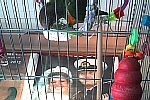|
Government
"Ask not what you can do for your country,
ask what your country can do for you!"
Since 1815 our country has a socalled (paradoxical sounding)
Constitutional Monarchy
with a Parliamentary System or
Representation of the people
which goes back until 1588.

The
government
is formed by our queen (being the head of state) and the ministers.
The head of state is immune and the ministers take the responsibility.
The
Cabinet
consists of all the ministers and state secretaries. They are not a member of the Lower House.
The
Lower House
has 150 members who are directly chosen by the citizens.
The
Upper House
(or Senate) has 75 members, indirectly chosen.
The
Parlement
(or States General) consist of the Upper and Lower Houses.
However only in Dutch, the last website gives a clear explanation under the link regering - organisatie - samenvatting.

There are five High Councils of State, known as the
Lower House
(Tweede Kamer) to control the government and to legislate; the
Upper House
(Eerste Kamer) to control the government and to pass or adopt the bills; the
Court of Audit
investigates whether Dutch public funds are collected and spent regularly and effectively; The
National Ombudsman
is there for complaints against the government. And there is our
Council of State
who gives advice on bills and international agreements to the head of state.
This is also the highest court for disputes between the citizen and his government.
The state councillors are appointed
for life by the queen, on recommendation of the minister of Foreign Affairs.

We are free to vote on the party of our choice. After the elections there is a socalled
Kabinetsformatie
healt: a couple of political parties who in total form a majority, will negotiate with each other.
Each of them will drop some points of their election program and they formulate a
coalition agreement. If it doesn't work out, it is tried again with another party coalition.
The direction is in the hands of a socalled (in)formateur who is of course appointed by the queen.
Finally, all the ministerial posts will be divided among the members of this new formed cabinet.
So it doesn't mean that the biggest party automatically becomes a of the cabinet.
Beside that the parties who form the cabinet just might drop those election points
which determined the choice of voting.

Our latest long sitting Prime Minister is
Wim Kok
(1994 to 2002), leader of the
Purple cabinet.
He is the one who successfully has beaten the Dutch millennium bug,
and also tried using a mouse as a tv remote on national tv.
He is also the one who gave the word
poldermodel
a new, international known meaning.
The Dutch government resigned
in April 2002 due to the Srebrenica issue. During the following election campain politician
Pim Fortuyn
was assassinated by a left-extremist environmentalist.

The government is situated in 's-Gravenhage (The Hague) while Amsterdam is the capital and
the largest city. The queen's palace is in Amsterdam (on the Dam), but she doesn't live in it.
Her home is, among many others, Paleis Huis ten Bosch, and her workspot is Paleis Noordeinde,
both in The Hague.

On February 2nd 2002, crownprince Willem Alexander and Máxima Zorreguieta got married.
The festivities were held in Amsterdam, the capital city of the Netherlands.
Take a look at my
photo report.

We basically have a socialist government, which means that
everyone has a basic income (plus holiday money),
health ensurance and a roof over their head.
This all is resulting in a lower crime rate, no doubt.
A workweek consist of max 40 hours, 36 is common.
We strive for 32, we have 4 weeks (paid) holidays,
and the part-time market is booming.
Interesting present information will be found on the website of our
Ministry of Foreign Affairs.
|
óne poopie means

locked up for life
|

